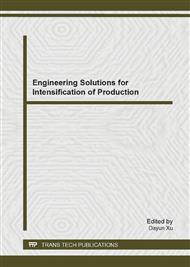p.82
p.88
p.95
p.101
p.105
p.111
p.121
p.129
p.135
Influence of Emulsion on the Corrosion and Scaling on Pipelines of Cooling System Deep Coal Mine: A Experiment Study
Abstract:
Scaling and corrosion are the two problems of the cooling system. In this paper, the influence of emulsion on the corrosion and scaling on pipelines of cooling system deep coal mine is studied by the experiment. Firstly, the characteristics of water consist in the pipe of cooling system are received; secondly, 12 kinds of emulsion were prepared in the experiment and characteristics of the water mixed with emulsion are tested; Finally, we calculated the IS, IR at the cases of different temperatures and put forward the mass fraction of emulsion which can prevent the scaling and corrosion. The results are as follows.1) When the water temperature is higher than 37°C, there will be no corrosion and scaling when no joins of emulsion.2) When the water temperature is 27~37°C, the pipeline surface will be little corroded by the mining water, and the joining of emulsion with the mass fraction of 1~2% can prevent scaling and corrosion.3) When the water temperature is higher than 27°C, the pipeline surface will be corroded by the mining water, and the joining of emulsion with the mass fraction of 3~4% can prevent scaling and corrosion. The research is of great importance to the cooling under deep coal mine, at the same time to the scale inhibition and anticorrosion on the geothermal engineering.
Info:
Periodical:
Pages:
105-110
Citation:
Online since:
February 2014
Authors:
Price:
Сopyright:
© 2014 Trans Tech Publications Ltd. All Rights Reserved
Share:
Citation:


